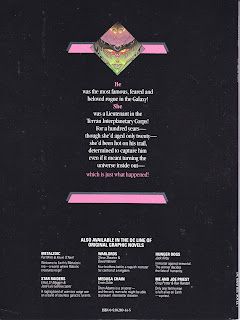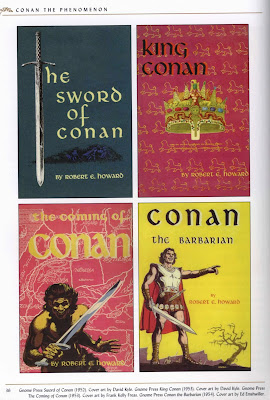Book Review: The 'Timeliner' trilogy by Richard C. Meredith
3 / 5 Stars
Richard C. Meredith (1937 – 1979) wrote a number of sf novels, such as ‘We All Died At Breakaway Station’, ‘The Sky is Filled with Ships’, and ‘The Awakening’.
‘At the Narrow Passage’ was first published in 1973 in hardcover, followed by ‘No Brother, No Friend’ in 1976, and ‘Vestiges of Time’ in 1978.
Meredith made arrangements with Playboy Press to republish a revised edition of the ‘Timeliner' trilogy, starting with ‘Passage’ in September 1979, and continuing with ‘Friend’ in October and ‘Vestiges’ in November. Shortly after the revised trilogy was released, in March, 1979, Meredith died suddenly of a stroke.
The Playboy Press versions thus represent the final editions of the Timeliner novels. All three volumes have cover artwork by Kenn Barr.
The Timeliner novels borrow from H. Beam Piper’s ‘Paratime’ canon, in that they posit an infinite number of parallel universes simultaneously co-existing, without knowledge of one another’s existence.
As ‘At the Narrow Passage’ opens, the protagonist, Eric Mathers, a Captain of the British Infantry, is preparing for a commando mission. It’s Spring, 1971, and on para RTGB-307, the First World War is raging.
Eric Mathers is an agent for a lizard-like alien race called the ‘Krith’. The Krith have the ability to travel at will across paratimes, using a kind of teleportation unique to their physical makeup. Acting in shadow and stealth, the Krith manipulate human affairs on hundreds of paratime worlds. Eric Mathers has signed on an as agent for the Krith because he believes their argument that they are working for the ultimate good of the human race, by preventing paras from destroying themselves in nuclear wars. According to the Kriths, the loss of too many para civilizations to self-destruction can jeopardize the stability of adjoining paras.
The mission the Kirth have selected for Eric Mathers and his comrades is dangerous: they are to sneak behind the German lines and infiltrate a chateau in Beaugency, where a German officer named Count Albert von Heinen is staying. They are to capture von Heinen and transport him back to British lines. Why is von Heinen important ? Because he is in charge of the German effort to construct an Atomic Bomb – the first one to exist in this particular paratime.
Eric Mathers embarks on his mission, albeit with reservations, and soon finds that all is not what it seems. Have the Krith been less than open with him about their true intentions ? When Mathers decides to investigate the motives of the Krith, a decision that takes him across a wide span of parallel universes, he comes to a growing awareness that a vast and brutal struggle is being waged across the paratimes. And that the fate of the Universe, not just Mankind, may come to rest on his shoulders…..
Overall, the Timeliner trilogy succeeds as adventure sf, with the inclusion of some ‘cosmic’ aspects to lend a note of sophistication to the run-and-gun actions sequences that dominate the first two volumes.
There also are plenty of Sexytime passages (Meredith evidently published a volume of erotic poetry ?! at one time in his writing career), involving an array of oversexed females who are ever-ready to unlcothe for the benefit of our square-jawed hero......but, then, this is not unheard- of activity for any 70s adventure novel.
The third volume is the weakest; while I won’t disclose any spoilers, it spends much of its length devoted to the somewhat clichéd sf trope of the Disembodied Consciousness Wandering the Universe.
As well, Meredith made an effort to address Deep Metaphysical Questions about the meaning of life, time, and existence; this sort of thing is difficult to pull off in what is essentially a space opera, and the third installment suffers because of it.
However, despite the underwhelming nature of the final volume, the Timeliner trilogy is one of the better adventure series to appear in the 70s, particularly when you consider that at the time it first was published in the early- to mid- 70s, that sub-genre of straightforward, entertaining sf was being neglected in favor of novels that were self-consciously 'literary', a consequence of the changes wrought by the advent of the New Wave.
That makes all three volumes worth searching out; they can be purchased for reasonable prices at your usual online used-book dealers.
3 / 5 Stars
Richard C. Meredith (1937 – 1979) wrote a number of sf novels, such as ‘We All Died At Breakaway Station’, ‘The Sky is Filled with Ships’, and ‘The Awakening’.
‘At the Narrow Passage’ was first published in 1973 in hardcover, followed by ‘No Brother, No Friend’ in 1976, and ‘Vestiges of Time’ in 1978.
Meredith made arrangements with Playboy Press to republish a revised edition of the ‘Timeliner' trilogy, starting with ‘Passage’ in September 1979, and continuing with ‘Friend’ in October and ‘Vestiges’ in November. Shortly after the revised trilogy was released, in March, 1979, Meredith died suddenly of a stroke.
The Playboy Press versions thus represent the final editions of the Timeliner novels. All three volumes have cover artwork by Kenn Barr.
The Timeliner novels borrow from H. Beam Piper’s ‘Paratime’ canon, in that they posit an infinite number of parallel universes simultaneously co-existing, without knowledge of one another’s existence.
As ‘At the Narrow Passage’ opens, the protagonist, Eric Mathers, a Captain of the British Infantry, is preparing for a commando mission. It’s Spring, 1971, and on para RTGB-307, the First World War is raging.
Eric Mathers is an agent for a lizard-like alien race called the ‘Krith’. The Krith have the ability to travel at will across paratimes, using a kind of teleportation unique to their physical makeup. Acting in shadow and stealth, the Krith manipulate human affairs on hundreds of paratime worlds. Eric Mathers has signed on an as agent for the Krith because he believes their argument that they are working for the ultimate good of the human race, by preventing paras from destroying themselves in nuclear wars. According to the Kriths, the loss of too many para civilizations to self-destruction can jeopardize the stability of adjoining paras.
The mission the Kirth have selected for Eric Mathers and his comrades is dangerous: they are to sneak behind the German lines and infiltrate a chateau in Beaugency, where a German officer named Count Albert von Heinen is staying. They are to capture von Heinen and transport him back to British lines. Why is von Heinen important ? Because he is in charge of the German effort to construct an Atomic Bomb – the first one to exist in this particular paratime.
Eric Mathers embarks on his mission, albeit with reservations, and soon finds that all is not what it seems. Have the Krith been less than open with him about their true intentions ? When Mathers decides to investigate the motives of the Krith, a decision that takes him across a wide span of parallel universes, he comes to a growing awareness that a vast and brutal struggle is being waged across the paratimes. And that the fate of the Universe, not just Mankind, may come to rest on his shoulders…..
Overall, the Timeliner trilogy succeeds as adventure sf, with the inclusion of some ‘cosmic’ aspects to lend a note of sophistication to the run-and-gun actions sequences that dominate the first two volumes.
There also are plenty of Sexytime passages (Meredith evidently published a volume of erotic poetry ?! at one time in his writing career), involving an array of oversexed females who are ever-ready to unlcothe for the benefit of our square-jawed hero......but, then, this is not unheard- of activity for any 70s adventure novel.
The third volume is the weakest; while I won’t disclose any spoilers, it spends much of its length devoted to the somewhat clichéd sf trope of the Disembodied Consciousness Wandering the Universe.
As well, Meredith made an effort to address Deep Metaphysical Questions about the meaning of life, time, and existence; this sort of thing is difficult to pull off in what is essentially a space opera, and the third installment suffers because of it.
However, despite the underwhelming nature of the final volume, the Timeliner trilogy is one of the better adventure series to appear in the 70s, particularly when you consider that at the time it first was published in the early- to mid- 70s, that sub-genre of straightforward, entertaining sf was being neglected in favor of novels that were self-consciously 'literary', a consequence of the changes wrought by the advent of the New Wave.
That makes all three volumes worth searching out; they can be purchased for reasonable prices at your usual online used-book dealers.





















































































































 The
The 







